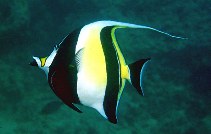| Family: |
Zanclidae (Moorish idol) |
| Max. size: |
23 cm TL (male/unsexed) |
| Environment: |
reef-associated; marine; depth range 0 - 182 m |
| Distribution: |
Indo-Pacific: East Africa to Rapa and Ducie islands, north to southern Japan and the Hawaiian Islands, south to the Lord Howe Island. Eastern Pacific: southern Gulf of California to Peru (Ref. 9267). |
| Diagnosis: |
Dorsal spines (total): 6-7; Dorsal soft rays (total): 39-43; Anal spines: 3-3; Anal soft rays: 31-37. Strongly compressed discoid body. Tubular snout with a small mouth containing numerous elongate bristle-like teeth. Dorsal spines elongated into a whip-like filament.
Description: Characterized further by having distinctive pattern of alternating yellow and black bars; long snout and tubular with small mouth; teeth slender, slightly incurved and in an single row in each jaw; adult with bony projection in front of each eye (Ref. 90102). |
| Biology: |
Inhabit turbid inner lagoons, reef flats, and clear seaward rocky and coral reefs (Ref. 1602, 48637). Benthopelagic (Ref. 58302). Generally encountered in small groups of 2 or 3 individuals (Ref. 9267). Adults occur singly, in pairs and occasionally are seen in large schools (Ref. 48637). Feed on small encrusting animals (Ref. 6113). Size of metamorphosis from postlarva to juvenile is 7.5 cm (Ref. 9267). The long pelagic larval stage is the reason for the wide distribution and strong colouration that shows no geographical variation (Ref. 48637). Popular aquarium fish but rarely survives in tanks (Ref. 1602). Minimum depth reported taken from Ref. 128797. |
| IUCN Red List Status: |
Least Concern (LC); Date assessed: 10 March 2015 Ref. (130435)
|
| Threat to humans: |
harmless |
Source and more info: www.fishbase.org. For personal, classroom, and other internal use only. Not for publication.

